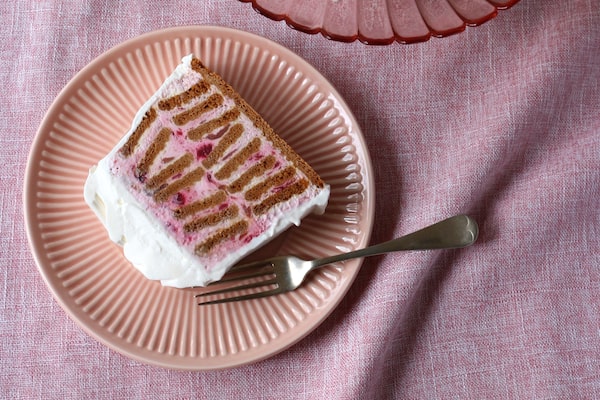
Rhubarb Biscoff Icebox Cake.Julie Van Rosendaal/The Globe and Mail
Brilliant pink-red rhubarb is one of the most exciting things to emerge from the thawing soil each spring, bringing a promise of pie and crumble to urban foragers willing to tuck a paring knife in their back pockets and harvest the crowns unfurling in the corners of yards and between recycling bins in back alleys.
Though it does exceedingly well in desserts (along with its seasonal soulmate, strawberries), rhubarb has more potential in savoury dishes than we often give it credit for – the stalks are slightly less acidic than lemon juice or vinegar, but can lend a similar tartness to savoury dishes. The brilliant pink colour is a bonus – a cheerful way to celebrate the arrival of longer, warmer spring and summer days.
Rhubarb Chutney
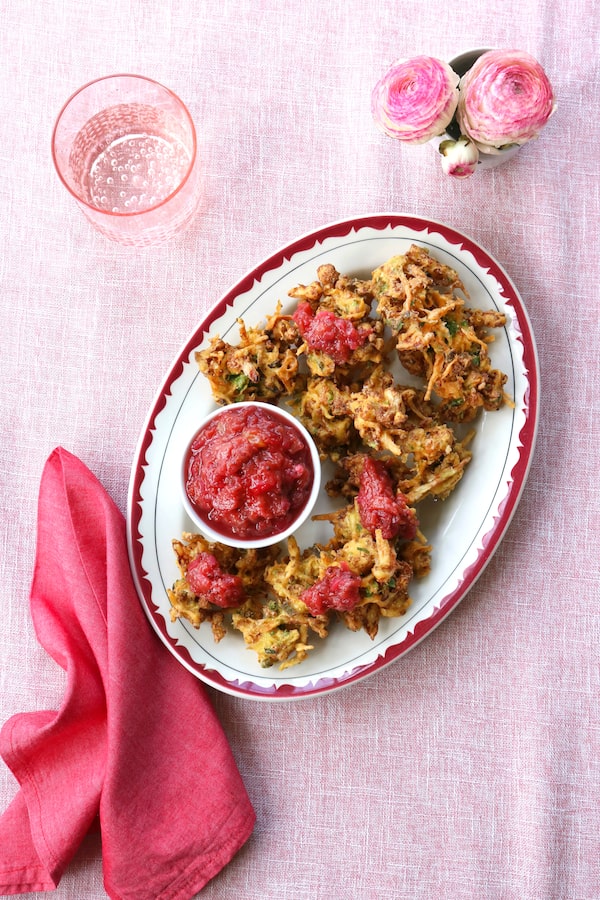
Julie Van Rosendaal/The Globe and Mail
Rhubarb makes a fantastic sweet-tart chutney that freezes well and keeps in the fridge for weeks. Pair it with roasted meats, fish and vegetables, cheeses or crispy pakoras, pictured here. Don’t worry about precise measurements – aim for a soft, saucy texture, and adjust the sugar, vinegar and spices as you like it.
Ingredients (makes about 1 cup)
1 small shallot or a chunk of red onion, finely chopped
2-3 cups chopped rhubarb (fresh or frozen)
1/4 cup golden raisins (optional)
2 tsp grated fresh ginger
1/2 cup sugar (white or brown)
1/4 cup apple cider or red wine vinegar
1 tsp black mustard seed
1 cinnamon stick
Pinch of red chili flakes
Pinch of salt
Combine everything in a large saucepan, bring to a simmer, reduce the heat and cook for 10 to 15 minutes, until the rhubarb starts to break down and the mixture is saucy – add a splash of water if it looks dry.
Remove the cinnamon stick and spoon into a jar, or other container, to store in the fridge for up to a month, or freeze for longer.
Rhubarb Vinaigrette
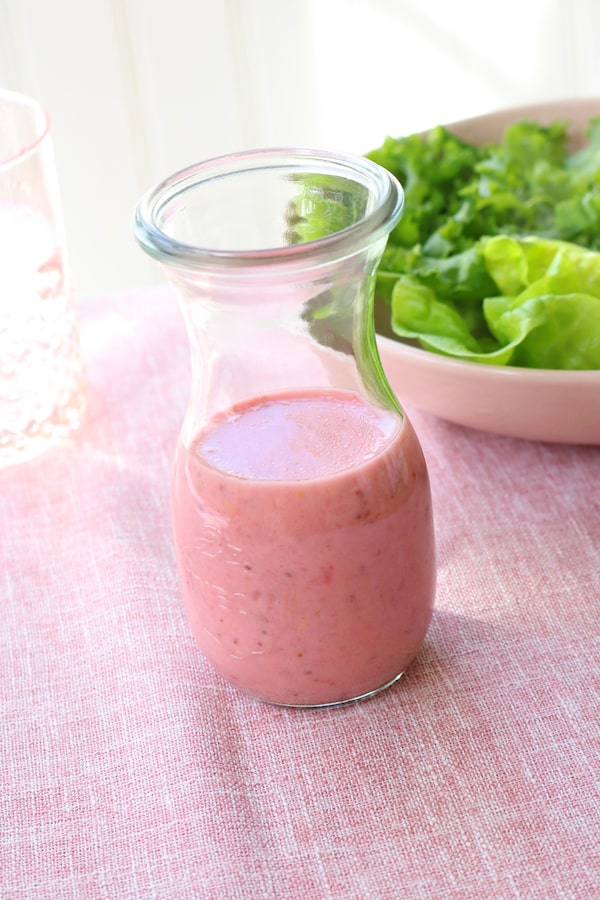
Julie Van Rosendaal/The Globe and Mail
Soft stewed rhubarb makes a wonderfully pink vinaigrette, the fibre adding body to the dressing and helping it emulsify. You can simmer a single stalk with a bit of water just for this purpose, or dip into a batch you already have hanging out in the fridge.
Ingredients (makes about 3/4 cup)
1 small rhubarb stalk or about 1/4 cup stewed rhubarb (sweetened or not)
2 tbsp rice, white wine or apple cider vinegar
1-2 tbsp honey
1-2 tsp grainy or Dijon mustard
1/2 cup canola or other mild vegetable oil
If you’re starting with raw or frozen rhubarb, chop it and put it into a small saucepan, add about 1/4 cup water and simmer for about 10 minutes, or until very soft; mash and set aside to cool slightly.
Whisk or blend the rhubarb, vinegar, honey, mustard and oil in a small blender or with a hand-held immersion blender until smooth. Store in a jar in the fridge for up to a month.
Rhubarb Aioli
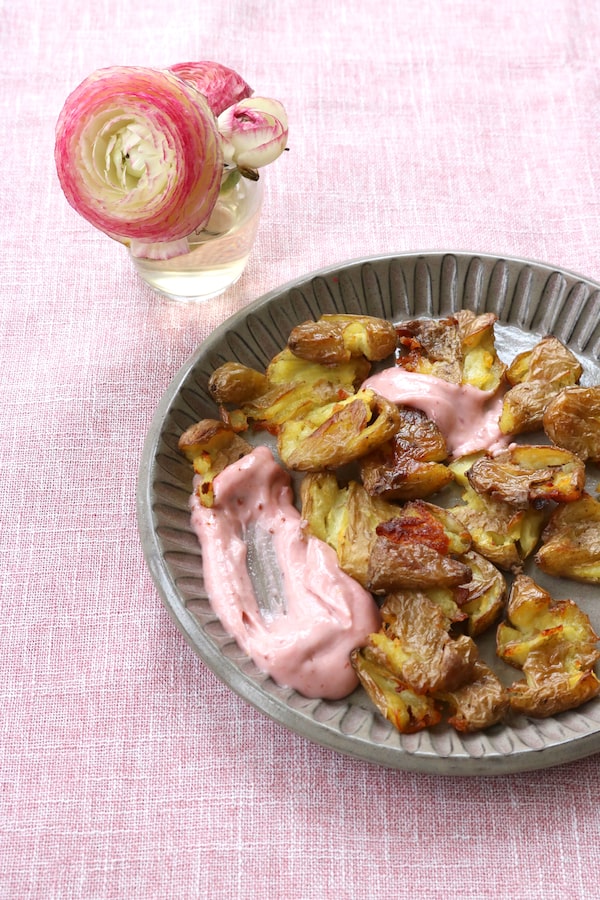
Julie Van Rosendaal/The Globe and Mail
Pale pink aioli is delicious with roasted chicken or fish, crispy fries or roasted potatoes, and can be used to dress all kinds of spring and summer dishes – it pairs well with cold pasta salads, potatoes and poached or grilled salmon. You could stew a stalk just for this, or use a big spoonful of a batch you already have in the fridge.
Ingredients (makes about 1 cup)
1 small rhubarb stalk or 1/4 cup stewed rhubarb (sweetened or not)
1 egg yolk or 2-3 tbsp liquid from canned chickpeas or white kidney beans
1 tsp mustard
pinch salt
3/4 cups canola or other mild vegetable oil
If you’re starting with raw or frozen rhubarb, chop it and put it into a small saucepan, add about 1/4 cup water and simmer for about 10 minutes, or until very soft; set aside to cool slightly.
Put the rhubarb and its cooking liquid (you’ll need about 1/4 cup) into a tall-sided measuring cup or other vessel along with the egg yolk, mustard and a pinch of salt. Top up with the oil to make 1 cup.
Put a hand-held immersion blender into the measuring cup, all the way to the bottom, and turn it on. Hold it in place for about 10 seconds, then slowly pull it up through the mixture as it thickens. Store in the fridge for up to a week.
Rhubarb Biscoff Icebox Cake
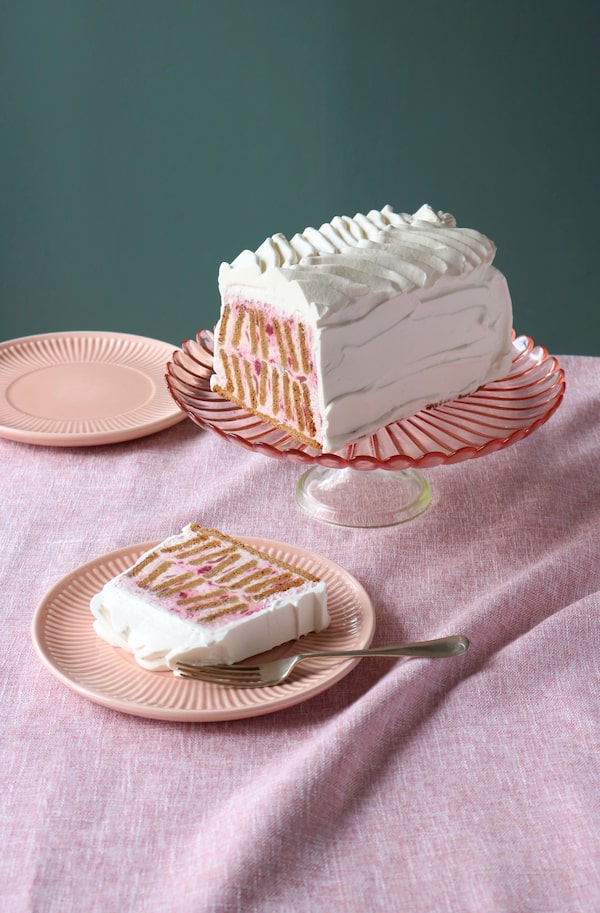
Julie Van Rosendaal/The Globe and Mail
You may be familiar with those old-school dessert logs made with chocolate wafers spread with whipped cream that soften to a sliceable consistency in the fridge; this version is made with Biscoff cookies and swirly pink rhubarb fool. Served chilled or frozen (fully or partially) it’s a gorgeous make-ahead dessert for special events, or one you can keep in the freezer to slice as needed – just for yourself.
Ingredients (serves 8 to 10)
4 cups chopped fresh or frozen rhubarb
3/4 cup sugar
3 cups whipping cream (divided)
3 tbsp icing sugar (divided)
1/4 tsp vanilla
2 packages Biscoff (or thin gingersnaps, or speculoos-style cookies)
In a large saucepan, simmer the rhubarb and sugar for 10 to 15 minutes, until the rhubarb softens and breaks down. (If it’s fresh, a splash of water may help get it started.) Once you have a chunky sauce, set it aside to cool, then refrigerate until cold. (You can do this up to a week ahead of time.)
In a large bowl, beat 2 cups of the whipping cream with 2 tbsp of the icing sugar and the vanilla until soft peaks form. Fold in the cooled rhubarb compote, leaving it swirly.
Line an 8- by 4-inch loaf pan – a high-sided one, if you have it – with plastic wrap. Spread some of the rhubarb fool over the bottom, then start spreading cookies with some of the fool and stacking them upright on their sides, in rows like books. (It doesn’t really matter how you arrange the cookies – just think of them as bricks, with the fool as mortar, and imagine what the resulting cross-section will look like.)
Stack the cookies until your loaf pan is full – some will accommodate two rows of cookies, but shallower pans are only deep enough for one, though you could stack a few cookies flat to fill any extra space. End with a layer of cookies on the top, which will wind up as the base. Cover with plastic wrap and refrigerate or freeze. (It will be more stable if frozen, and can thaw a bit before slicing, or once slices are on plates.)
When it’s time to serve, whip the remaining cup of whipping cream with a tablespoon of icing sugar until soft-stiff peaks form. Invert the icebox cake onto a serving plate or cutting board. (If it’s frozen, you may need to let it sit for a few minutes, or place a warm cloth on the outside of the pan for a minute to help it release.) Remove the plastic wrap and spread or pipe the whipped cream all over the sides and top. If it’s frozen, let stand at room temperature for about 20 minutes to make it easier to slice.
Slice to serve and if you like, let the pieces stand on the plate for a few minutes to thaw before serving – they will keep their shape but be soft, like cookies and cream.
Eton Mess
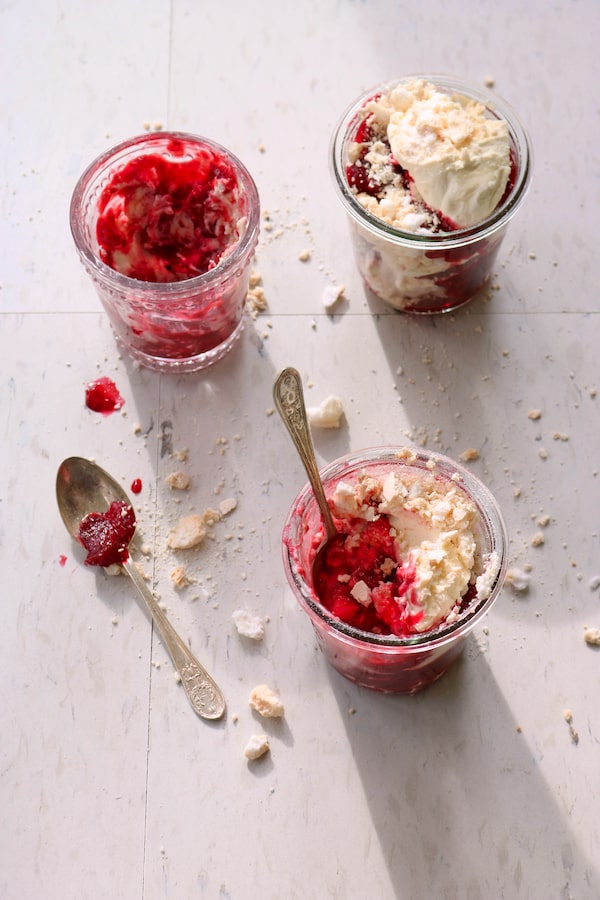
Julie Van Rosendaal/The Globe and Mail
Rhubarb Eton mess is a classic British trifle-meets-pavlova dessert, commonly made with the first stalks of the season. Feel free to add other juicy fruits to the mix – berries, plums and peaches pair well with rhubarb and can be chopped and added as it simmers. Start with store-bought meringues if you want to streamline the process; homemade tend to be a bit more marshmallow-y, if you like them that way.
Ingredients (serves 6 to 8)
3/4 cup sugar
1 tsp cornstarch
3 large egg whites
4 cups chopped fresh or frozen rhubarb
3/4 cup + 2 tbsp sugar (divided)
2 cups whipping cream
1/4 tsp vanilla
To make the meringues, preheat the oven to 250 F. In a small bowl or measuring cup, stir together the sugar and cornstarch. In a large bowl, beat the egg whites until foamy; gradually add the sugar mixture, continuing to beat until it is all incorporated and the mixture holds stiff peaks. Drop in big spoonfuls all over a parchment-lined sheet – don’t worry about size or spacing, you’re going to bash them up anyway – and bake for about an hour, until they’re very dry. Turn off the oven and let them cool inside (they will dry out a bit more), or let them cool on the pan outside the oven.
Combine the rhubarb and the 3/4 cup sugar in a saucepan and cook over medium-high heat for 10 to 15 minutes, until the fruit softens and breaks down. Leave it chunky or stir and simmer until it completely breaks down, taste and add more sugar if it needs it, and set aside to cool. Refrigerate until well chilled. (Both meringues and stewed rhubarb can be made up to a week in advance.)
Whip the cream with a couple tablespoons of sugar and the vanilla until it holds soft peaks and break the meringues into pieces so you have a range of big chunks and little bits. In a trifle bowl or individual glasses, layer the meringue, cold stewed fruit and whipped cream. Serve immediately, or let it sit for a few minutes to allow the meringue to soften.
It isn’t spring if you can’t have rhubarb in everything
Simmer any quantity of chopped fresh or frozen rhubarb with sugar (3-4 tbsp per cup of rhubarb, or to taste), along with a splash of water or orange juice if you have fresh rhubarb and need help getting it started, until the rhubarb starts to break down and the mixture is soft and saucy. Continue to cook if you want it softer or thicker, then cool and refrigerate for at least a week, or freeze. Stewed rhubarb (or rhubarb compote) is delicious spooned over yogurt and granola, oatmeal, shortcakes or ice cream, or use it in a smoothie or milkshake (truly!) or in one of these recipes.
Plan your weekend with our Good Taste newsletter, offering wine advice and reviews, recipes, restaurant news and more. Sign up today.



